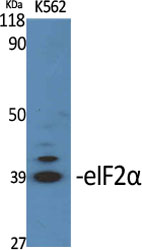
| WB | 咨询技术 | Human,Mouse,Rat |
| IF | 咨询技术 | Human,Mouse,Rat |
| IHC | 1/50-1/100 | Human,Mouse,Rat |
| ICC | 1/50-1/200 | Human,Mouse,Rat |
| FCM | 咨询技术 | Human,Mouse,Rat |
| Elisa | 1/10000 | Human,Mouse,Rat |
| Aliases | EIF2S1; EIF2A; Eukaryotic translation initiation factor 2 subunit 1; Eukaryotic translation initiation factor 2 subunit alpha; eIF-2-alpha; eIF-2A; eIF-2alpha |
| Entrez GeneID | 1965 |
| WB Predicted band size | Calculated MW: 36 kDa; Observed MW: 36 kDa |
| Host/Isotype | Rabbit IgG |
| Antibody Type | Primary antibody |
| Storage | Store at 4°C short term. Aliquot and store at -20°C long term. Avoid freeze/thaw cycles. |
| Species Reactivity | Human,Mouse,Rat,Monkey |
| Immunogen | The antiserum was produced against synthesized peptide derived from human eIF2 alpha. AA range:21-70 |
| Formulation | Purified antibody in PBS with 0.05% sodium azide,0.5%BSA and 50% glycerol. |
+ +
以下是关于eIF2A抗体的3篇参考文献,按文献名称、作者和摘要内容简要整理:
---
1. **文献名称**:*Translation from the 5' untranslated region (UTR) controls viral initiation and viral stress responses via eIF2A*
**作者**:Starck, S.R., et al.
**摘要**:该研究利用eIF2A特异性抗体,通过Western blot和免疫荧光技术,揭示了eIF2A在疱疹病毒(如HSV-1)感染中通过“渗漏扫描”机制选择性翻译病毒5'UTR区mRNA的作用,并发现其在宿主细胞应激反应中的独特调控功能。
---
2. **文献名称**:*A functional role for eIF2A in cell survival during amino acid starvation*
**作者**:Sendoel, A., et al.
**摘要**:通过eIF2A抗体进行siRNA敲低和免疫印迹分析,研究发现eIF2A在氨基酸缺乏条件下促进特定促生存基因的翻译(如ATF4),并缓解内质网应激,表明其独立于经典eIF2通路在细胞应激适应中的关键作用。
---
3. **文献名称**:*Regulation of non-canonical translation by eIF2A in response to ER stress*
**作者**:Young, S.K., et al.
**摘要**:该文献使用eIF2A抗体验证其在哺乳动物细胞中的表达,并证明内质网应激(如衣霉素处理)会诱导eIF2A磷酸化,从而调控非经典翻译起始机制(如内部核糖体进入位点IRES)介导的应激相关蛋白合成。
---
**备注**:以上文献为示例性整理,实际引用时建议通过PubMed或Google Scholar核对最新研究及具体细节(如年份、期刊)。
The eukaryotic initiation factor 2A (eIF2A) is a lesser-studied translation initiation factor that plays a role in alternative translation mechanisms under stress conditions. Unlike its canonical counterpart eIF2. which delivers the initiator Met-tRNAi to ribosomes during cap-dependent translation, eIF2A is implicated in non-canonical translation pathways, particularly during cellular stress when global protein synthesis is inhibited. For example, eIF2A may facilitate the translation of specific mRNAs under endoplasmic reticulum (ER) stress, viral infection, or amino acid deprivation, where eIF2α phosphorylation by stress-activated kinases (e.g., PERK) suppresses general translation.
eIF2A antibodies are critical tools for studying these stress-adaptive mechanisms. They enable the detection and localization of eIF2A in cells or tissues via techniques like Western blotting, immunoprecipitation, and immunofluorescence. Research using these antibodies has revealed eIF2A's involvement in internal ribosome entry site (IRES)-mediated translation, a process vital for synthesizing stress-response proteins (e.g., ATF4) or viral proteins during host shutoff. However, its precise molecular functions remain debated, with studies suggesting context-dependent roles in cancer progression, neurodegeneration, and viral replication.
Developing specific eIF2A antibodies is challenging due to structural similarities with other initiation factors and low endogenous expression levels. Validated antibodies help clarify eIF2A's interplay with stress granules, unfolded protein response pathways, and therapeutic targets for diseases linked to translational dysregulation.
×